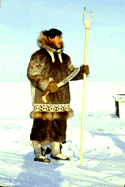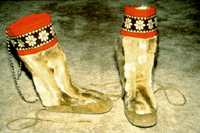|
Climate
and Cultural Barriers
to Northern Economic Development:
A case study from Broughton Island, N.W.T., Canada
Vol. 5: 91-98, 1995
CLIMATE RESEARCH
Clim. Res
Published February 23, 1995
Jill Oakes
Department of Native Studies, and Natural Resource Institute,
University of Manitoba, Winnipeg, Manitoba, Canada R3T 2N2
And
Canadian Circumpolar Institute, University of Alberta, Edmonton,
Alberta, Canada T6G 2J6
ABSTRACT
It is critical to study climate and cultural factors influencing
the handicraft industry in order to combat critical levels
of unemployment in northern settlements. The purpose of this
paper is to identify the climate and cultural factors influencing
production at the Minnguq Sewing Group in Broughton Island,
Northwest Territories, Canada. Participatory action research
methods, including participation in workshops, observing the
decision making processes, and informal interviews were used
during the field research conducted from January to August
1991.

|
Information was collected on various aspects of business including
product line development, production techniques, management
strategies, and funding sources. Climate and culture influenced
availability of resources, funding, and training; isolation
from consumers and supplies; and integration of new technology.
This study will be of interest to scientists studying rural
economy, aboriginal economic development, international arts
and crafts, cross-cultural clothing, historical clothing,
and other related fields.
KEY WORDS: Culture, Arctic, Inuit, Aboriginal community economic
development, Handicrafts industry, Cross-cultural economic
development, Women in development, Northern business
INTRODUCTION
Industry recognizes the need to understand cultural influences
on productivity levels and devotion to producing products
(Jamieson 1987, Quigley & Mcbride 1987, Robinson &
Ghostkeeper 1987, Department of Economic Development and Tourism
1990, Stabler et al. 1990, Erasmus & Ensign 1991, Weissling
1991, Wuttunee 1992). Climate also plays a critical role in
economic development, especially when studying a specific
sector of the economy (Goos 1989). In order to develop effective
development strategies in the eastern Arctic, climate and
cultural factors need to be examined. The purpose of this
paper is to identify climate and cultural factors influencing
the Minnguq Sewing Group in Broughton Island, Northwest Territories
(N.W.T.), Canada, and to relate this information to relevant
literature on economic development.
|
Unemployment
has been a serious problem ever since the traditional economy
collapsed in the 1930s and 1940s (Stabler & Howe 1990).
Stabler & Howe (1990) and Stabler (1989) summarize historical,
contemporary, and future unemployment trends for the N.W.T.
The birth rate in the N.W.T. is 3 times the national average
with over 42% of the population less than 20 yr old. The
rapid increase in population, combined with extreme climate,
has strong socio-economic implications (Alan et al. 1993).
In 10 yr over 6000 new jobs will be needed in order to maintain
even the present low employment rate in the N.W.T. (Department
of Economic Development and Tourism 1990, Employment and
Immigration Canada 1990). Nationally, 5000 aboriginal people
must enter the work force annually for the next 5 yr in
order to maintain the current low employment rate for aboriginal
people (which is double the non-native rate of low employment)
(Jamieson 1987, Department of Economic Development and Tourism
1990). Education and specialized training are desperately
needed in order to alleviate the high unemployment rate
(Department of Economic Development and Tourism 1990, Stabler
& Howe 1990, Stabler et al. 1990). Inuit hold 3% of
the federal public service jobs in the Nunavut (eastern
Arctic) region and 45% of the Government of the Northwest
Territory (GNWT) jobs (Inuit Management and Development
Task Force 1986). At a time of rapidly growing population
and critical levels of unemployment, it is important to
understand the factors influencing successful employment
ventures.
METHODS
The Minnguq Sewing Group invited researchers, using participatory
action research methods, to help with specific aspects of
their business development. Field research was conducted
from January to August 1991 in Broughton Island. It was
conducted with the assistance of Val Kosmenko, Tamara Tuchak,
and members of the Minnguq Sewing Group. Informal interviews
with the seamstresses, hunters, and skin preparers were
used to collect information on the impact of climate and
culture on the product line development, decision making
processes, and production techniques. Analysis of collected
data identified climate and cultural factors inhibiting
and supporting economic development.
|
|
RESULTS
AND DISCUSSION
A summary of trade and employment activity in the Broughton
Island area and specifically at the Minnguq Sewing Group provides
an historical context. An analysis of the Minnguq Sewing Centre
reveals climate and cultural factors influencing business
success.
Broughton Island
The hamlet of Broughton Island is situated on an island with
the same name located off the rugged east coast of Baffin
Island in the eastern Canadian Arctic. Inuit from this area
saw their first non-native in 1606 when William Baffins ship
was caught in local pack ice. By the early 1600s, European
whalers explored the area and established a whaling station
at Kivitoo (65 km north of Broughton Island). This contact
initiated the first, long-term trading relationship between
these 2 groups in the Broughton Island area. In 1956-57, 61
Inuit moved permanently onto Broughton Island when the Distant
Early Warning (DEW) line station was under construction (Kemp1984,
Weissling 1991). Fifteen Inuit were formally employed at the
time. By 1957 a few Inuit were selling carvings at the DEW
line site (Graburn 1978). At this time Inuit womens contribution
to the informal economy was limited by a dramatic drop in
hunting activities around the DEW line site (because of increased
dependency on DEW line site supplies) which resulted in the
lack of necessary materials. By 1960, Inuit living near the
site resumed active hunting and their standard of living improved
dramatically (Weissling 1991). Women were able to contribute
to their families quality of life. According to Anders (1966),
wage employment earnings rose dramatically with social welfare
payments, seal skins sales, construction projects, and fur
sales. In 1968, a government-subsidized, territory wide carving
and handicraft cooperative was started by the Department of
Indian Affairs and Northern Development. This provided the
first source of formal cash income for Inuit women in Broughton-Pangnirtung
area (Weissling 1991). The cooperative now no longer exists.
|
Today,
the population of Broughton Island is 450 (Municipal Records
1991); over 95% are Inuit. The main economic activities are
harvesting marine mammals, waterfowl, caribou, and fish for
food, guiding non-natives on hunts, taking tourists on dog
sled or fishing trips, and selling handicrafts. A few Inuit
work at territorial, municipal, Parks Canada, hotel, and retail
jobs. Several main sources of income, including the DEW line
site, trapping, sealing and carving, have either been terminated
or the market has crashed (Department of Economic Development
and Tourism 1990). There is a definite need for economic development
that considers the Arctic climate, available resources, and
cultural attributes.
Minnguq
Sewing Group
In the 1960s, Inuit on Baffin Island started to produce clothing
for southern export (Graburn 1978, Inuit Fine Art Task Force
1985). The arts and crafts industry provided a link between
the pre-1950s land-based economy (hunting and trapping) and
the post-1970s commercial production economy (land claims,
government assistance). A community initiated economic development
project called the Minnguq (Inuktitut for beetle) Sewing Group
began in the late 1970s.
|
This
group was started by several Inuit women interested in selling
seal skin boots (Oakes 1991) (Fig. 1). They began by using
skin donated by their families to make footwear. Their business
expanded to about 400 boot sales per year by 1990 and a new
product line of bags. The number of seamstresses employed
by Minnguq varies seasonally and depends on other community
commitments. When requests for products are received, they
are announced on the local radio and seamstresses are invited
to let Minnguq know if they would like to fill that specific
order. Skin boots are the main sales item and sell for approximately
$250 a pair (depending on size and decoration). The hunters,
skin preparers, and sewers are paid by the piece. Consumers
are primarily from the Northwest Territories, although individuals
from Montreal, Winnipeg, Edmonton, and other southern cities
also purchase these products from the Minnguq Sewing Group.
Seamstresses advertise their products by word of mouth and
by a recently published catalogue.
The
territorial and federal government introduced the Canadian
Economic Development Strategy (CAEDS) in 1989. An economic
development officer began helping Minnguq fill in the seemingly
endless pages of paper work for government funding proposals.
Funds received from successful proposals were used to pay
for consultants, training workshops, and equipment including
industrial sewing machines. Non-native consultants were used
to train interested women in industrialized skin preparation
techniques, production techniques using industrial sewing
machines, and product line development skills. A local seal
skin tannery was funded to complement Minnguqs activities.
Governments must continue to play a positive, active role
in economic development (Gillis et al.1987, Stabler &
Howe 1990). It is critical for members of the Minnguq Sewing
Group to take into consideration the factors influencing their
business, including climate and cultural barriers, as well
as the beneficial aspects of these factors. These considerations
are also important when developing training programs, which
will help to build the linkage between traditional and contemporary
skills needed to successfully run this business.

|
|
|
|

|
|
|